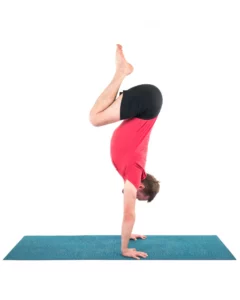How Does Yoga Work? New Theory Proposes Yoga Leads to Improved Self-Regulation

How does yoga work to combat stress and improve our psychological wellbeing? An interdisciplinary team of researchers suggests that one avenue might be improved self-regulation, which yoga is thought to facilitate through a complex physiological and neurological dance. As self-regulation improves so does our ability to manage stress and live with balance, mindfulness and intention. What’s more, we become more efficient at self-regulation with practice.
An increasing number of studies attest to the beneficial effects of yoga for a host of physical and psychological conditions. However, we still know little about the specific mechanisms or factors that may lead to these effects. A recent article in the journal Frontiers in Human Neuroscience suggests that yoga helps to improve our capacity for self-regulation. With increased self-regulation comes the ability to modulate stress and negative emotions, allowing us to face challenges with a greater sense of equanimity, or balance.
Self-regulation specifically refers to the ability to monitor our automatic responses to life events and to create alternate thoughts and behaviors. As we cultivate greater self-regulation we are able to exercise thoughtfulness and willpower instead of reacting to circumstances without thinking. We are able to tolerate discomfort in the service of maintaining our integrity and treating others with dignity, respect and kindness. It is the essence of what yoga teaches us.
Top-down and bottom-up processing
Researchers suggest that yoga cultivates the capacity for self-regulation using both top-down and bottom-up processing. Top-down processing refers to the use of focused attention and effort in the service of controlling our thoughts or behaviors. It includes cognitive skills such as planning, goal setting, monitoring, inhibition and meta-cognition.
In short, top-down activities require concentration and mental energy, particularly during the early phases of learning. For example, when practicing the ethical precepts of yoga (i.e. yamas and niyamas), we are often required to consciously evaluate how our behaviors are consistent with these principles. Over time and with a lot of practice, these principles become incorporated into how we move within the world and require less conscious effort.
Bottom-up processing emphasizes embodiment – or the input of bodily sensations into our experience. Research suggests that practices such as yoga asana (movement), pranayama (breath exercise) and meditation affect self-regulation through modulation of the autonomic nervous system in general, and the parasympathetic nervous system (PNS) in particular. Like top-down processing, we become more efficient and skilled at these practices over time.
The breath is the gateway to the autonomic system. Our bodies and brains interpret long, slow respiration (e.g. Anuloma Viloma) as a sign of safety and security. This activates our PNS. The PNS acts like a brake pedal, signaling that all is well. Rest, relaxation, digestion and psychological feelings of wellbeing are linked to PNS arousal. Activation of the PNS is a key antidote to the stress response when appropriate.
The sympathetic nervous system (SNS) is our system’s gas pedal. It is activated in the face of real or perceived threat. SNS activation initiates a cascade of neurological and physiological responses [e.g. increased heart rate, release of cortisol and stress hormones (CRH & ACTH)] to cope with stress or danger – think being chased by a tiger. Healthy SNS activation occurs in response to the body’s need to activate, be it running across the street to catch a bus or jumping out of the way of an oncoming car. This activation becomes unhealthy when the body perceives stress to be ongoing or chronic.
Breathing exercises like Kapalabhati Pranayama can increase respiration and heart rate to mimic SNS arousal. Practices such as these elicit the sensation of increased energy and activation and can be a useful antidote to lethargy or a sad mood.
The mind-body dance
Yoga is unique in that it activates both the top down and bottom up systems in ongoing reciprocal communication. According to this theory, yoga teaches us to unlearn our habitual responses through the interactions between these systems through practice. In essence, when we feel stress it often includes cognitive and emotional experiences such as a negative evaluation of the situation, emotional reactivity, and rumination. This is often accompanied by physical sensations such as muscle tension, pain and even inflammation. These painful states are also linked to autonomic nervous system functioning, with the stress response being linked to SNS activity. The more chronic the stress, the more likely we are to experience long-term physical and psychological distress and dis-ease, and to live in a near continuous state of hyperarousal.
Yoga teaches us mind-body awareness, and gives us the ability to consciously modulate our stress response through the breath, movement and intention. By linking the two systems through the 8 limbs of yoga, we become aware of physical sensations and use them to interpret our mental states. Likewise, we learn to understand the interplay between our negative thoughts and emotions and bodily sensations. This awareness allows us to use the tools of yoga to downshift the stress response, and to move toward a place of balance and wellness on and off the mat.
 B Grace Bullock, PhD, E-RYT 500 is a psychologist, research scientist, educator, author, yoga and mindfulness expert and creator of BREATHE: 7 Skills for Mindful Relationships. Her mission is to reduce stress, increase health and wellbeing and improve the quality of relationships. She offers classes, workshops, writing and research that combine the wisdom of applied neuroscience, psychophysiology, psychology and contemplative science and practice. Her goal is to empower individuals, groups, leaders and organizations to reduce chronic stress and increase awareness, attention, compassion, mindfulness and effective communication to strengthen relationships, release dysfunctional patterns and unlock new and healthy ways of being. Dr. Bullock is a Certified Viniyoga Therapist and Faculty at the Integrated Health Yoga Therapy (IHYT) Training program. She is the former Senior Research Scientist at the Mind & Life Institute and former Editor-in-Chief of the International Journal of Yoga Therapy. For more information see www.bgracebullock.com.
B Grace Bullock, PhD, E-RYT 500 is a psychologist, research scientist, educator, author, yoga and mindfulness expert and creator of BREATHE: 7 Skills for Mindful Relationships. Her mission is to reduce stress, increase health and wellbeing and improve the quality of relationships. She offers classes, workshops, writing and research that combine the wisdom of applied neuroscience, psychophysiology, psychology and contemplative science and practice. Her goal is to empower individuals, groups, leaders and organizations to reduce chronic stress and increase awareness, attention, compassion, mindfulness and effective communication to strengthen relationships, release dysfunctional patterns and unlock new and healthy ways of being. Dr. Bullock is a Certified Viniyoga Therapist and Faculty at the Integrated Health Yoga Therapy (IHYT) Training program. She is the former Senior Research Scientist at the Mind & Life Institute and former Editor-in-Chief of the International Journal of Yoga Therapy. For more information see www.bgracebullock.com.



